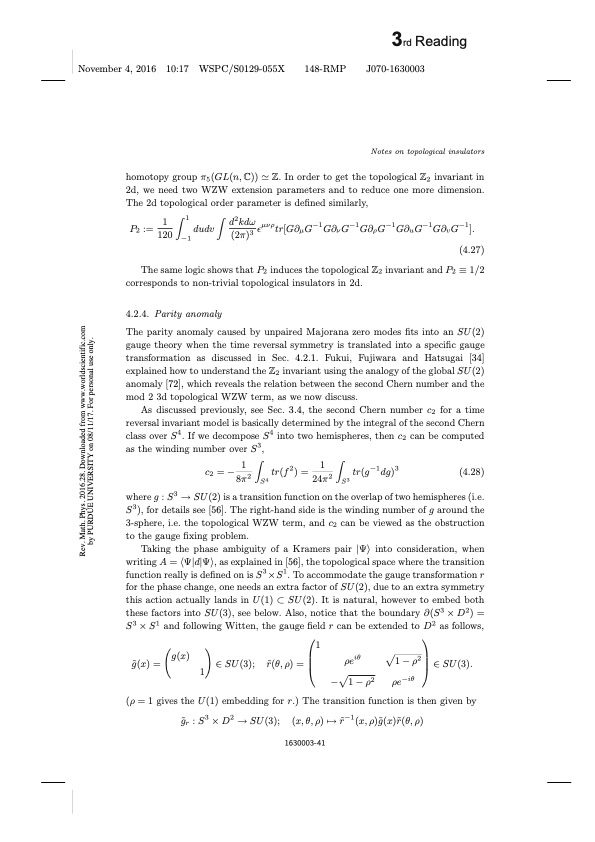
PDF Publication Title:
Text from PDF Page: 041
homotopy group π5(GL(n,C)) ≃ Z. In order to get the topological Z2 invariant in 2d, we need two WZW extension parameters and to reduce one more dimension. The 2d topological order parameter is defined similarly, −1 1 1 d2kdω μνρ −1 −1 −1 −1 −1 P2 := 120 The same logic shows that P2 induces the topological Z2 invariant and P2 ≡ 1/2 dudv (2π)3 ε tr[G∂μG G∂νG G∂ρG G∂uG G∂vG ]. (4.27) Notes on topological insulators corresponds to non-trivial topological insulators in 2d. 4.2.4. Parity anomaly The parity anomaly caused by unpaired Majorana zero modes fits into an SU(2) gauge theory when the time reversal symmetry is translated into a specific gauge transformation as discussed in Sec. 4.2.1. Fukui, Fujiwara and Hatsugai [34] explained how to understand the Z2 invariant using the analogy of the global SU(2) anomaly [72], which reveals the relation between the second Chern number and the mod 2 3d topological WZW term, as we now discuss. As discussed previously, see Sec. 3.4, the second Chern number c2 for a time reversal invariant model is basically determined by the integral of the second Chern class over S4. If we decompose S4 into two hemispheres, then c2 can be computed as the winding number over S3, 1 1 c2 = − 2 tr(f2) = 2 tr(g−1dg)3 (4.28) where g : S3 → SU(2) is a transition function on the overlap of two hemispheres (i.e. S3), for details see [56]. The right-hand side is the winding number of g around the 3-sphere, i.e. the topological WZW term, and c2 can be viewed as the obstruction to the gauge fixing problem. Taking the phase ambiguity of a Kramers pair |Ψ⟩ into consideration, when writing A = ⟨Ψ|d|Ψ⟩, as explained in [56], the topological space where the transition function really is defined on is S3 ×S1. To accommodate the gauge transformation r for the phase change, one needs an extra factor of SU(2), due to an extra symmetry this action actually lands in U(1) ⊂ SU(2). It is natural, however to embed both these factors into SU(3), see below. Also, notice that the boundary ∂(S3 × D2) = S3 × S1 and following Witten, the gauge field r can be extended to D2 as follows, 1 8π S4 24π S3 g ̃(x)= g(x) ∈SU(3); r ̃(θ,ρ)= ρeiθ 1−ρ2∈SU(3). 1 2−iθ −1−ρ ρe (ρ = 1 gives the U(1) embedding for r.) The transition function is then given by 32 −1 g ̃r :S ×D →SU(3); (x,θ,ρ)→r ̃ (x,ρ)g ̃(x)r ̃(θ,ρ) 1630003-41 Rev. Math. Phys. 2016.28. Downloaded from www.worldscientific.com by PURDUE UNIVERSITY on 08/11/17. For personal use only.PDF Image | Notes on topological insulators

PDF Search Title:
Notes on topological insulatorsOriginal File Name Searched:
RMP.pdfDIY PDF Search: Google It | Yahoo | Bing
Sulfur Deposition on Carbon Nanofibers using Supercritical CO2 Sulfur Deposition on Carbon Nanofibers using Supercritical CO2. Gamma sulfur also known as mother of pearl sulfur and nacreous sulfur... More Info
CO2 Organic Rankine Cycle Experimenter Platform The supercritical CO2 phase change system is both a heat pump and organic rankine cycle which can be used for those purposes and as a supercritical extractor for advanced subcritical and supercritical extraction technology. Uses include producing nanoparticles, precious metal CO2 extraction, lithium battery recycling, and other applications... More Info
| CONTACT TEL: 608-238-6001 Email: greg@infinityturbine.com | RSS | AMP |